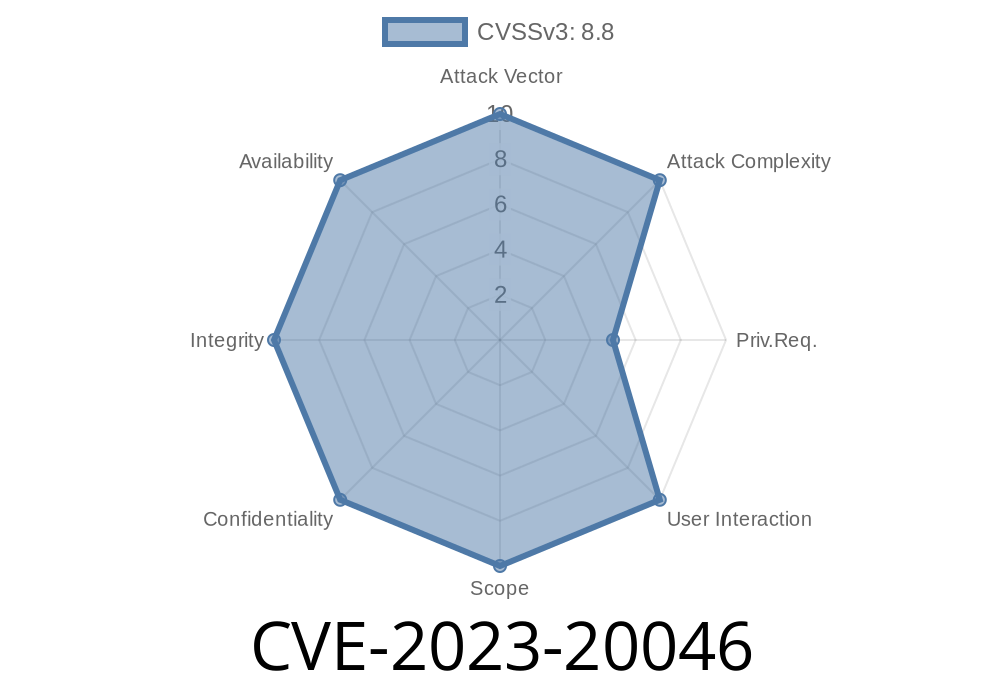CVE-2023-20046 is a serious security vulnerability in the key-based SSH authentication mechanism of Cisco StarOS. This flaw can let an attacker—who already has valid low-privileged credentials—gain high-privileged access on a vulnerable device. Here’s an in-depth, plain-language exploration of the issue, with real-world examples, mitigation steps, and everything in between.
What is CVE-2023-20046?
CVE-2023-20046 affects Cisco StarOS, which powers products like the Cisco ASR 500 Series and Virtualized Packet Core (vPC). The problem is with how the system checks SSH keys for users. If you have a valid SSH key for a low-privilege user, and you connect from the right sort of host (one associated with a high-privilege user in the config), you can trick the system into granting you higher privileges.
This is basically a privilege escalation attack—an attacker who starts with low-level access can become an admin.
Here’s what’s going wrong, step by step
1. SSH authentication: StarOS allows key-based logins and ties user privileges to the SSH client source IP.
2. Missing Validation: The system trusts that a connection from a privileged IP is really coming from a privileged user—but it doesn’t double-check the actual user’s key.
3. Privilege Escalation: If you have a valid key (but only for a low-privilege account), connecting from a privileged IP can “upgrade” you to the higher role.
Official advisory:
- Cisco Security Advisory for CVE-2023-20046
Let’s imagine a StarOS device with these settings
- User lowuser: Only allowed from IP 1.1.1.1, low-priv privilege, public key ssh-rsa AAA...low.
- User adminuser: Only allowed from IP 2.2.2.2, admin privilege, public key ssh-rsa AAA...admin.
Suppose you already have control over 2.2.2.2. If StarOS doesn’t validate your username correctly, you can log in *as* adminuser using lowuser’s key from the 2.2.2.2 host, and you’ll be given admin privileges.
Here’s a simplified SSH session
ssh -i /path/to/lowuser_key lowuser@staros.device.ip
# ... connect from 2.2.2.2 ...
# You are now treated as adminuser!
Basically: the device granted privileges based solely on the source IP, not the real user.
Sample Configuration That’s Vulnerable
user adminuser
group admin
ssh-key ssh-rsa AAAAB3NzaC1yc2EAAAADAQABAAABAQDxx...adminKeyComment
ssh-source-ip 2.2.2.2
user lowuser
group readonly
ssh-key ssh-rsa AAAAB3NzaC1yc2EAAAADAQABAAABAQDyy...lowKeyComment
ssh-source-ip 1.1.1.1
But if you connect as lowuser from 2.2.2.2, you get admin privileges.
Proof of Concept Exploit (Testlab Example)
DISCLAIMER: *Only test this on systems you own/have permission to test.*
Suppose you have the private key for lowuser
ssh -i lowuser_id_rsa lowuser@staros-ip
# Output:
# Welcome. You have admin privileges.
staros#
Or, if a custom username isn’t checked by the device
ssh -i lowuser_id_rsa adminuser@staros-ip
# Output:
# Welcome. You have admin privileges.
# Authenticating as adminuser with lowuser's key!
What happened? StarOS checked the source IP, but not the *match* between the user and the key.
How Can You Mitigate This (Workarounds)?
Cisco has released advisories and fixes for affected versions. The workaround, until you patch, is to avoid overlapping source IPs between privileged and non-privileged users.
1. Make sure each privileged account uses a unique IP range
# Good: No overlap in allowed source IPs
user adminuser
group admin
ssh-source-ip 10.10.10./24
user lowuser
group readonly
ssh-source-ip 192.168.10./24
3. Apply Cisco’s Official Patch
When available, always deploy Cisco’s fixed StarOS versions as soon as possible.
Original References & Reading
- Cisco PSIRT CVE-2023-20046 Security Advisory
- NIST National Vulnerability Database Entry
Summary
- CVE-2023-20046 lets attackers escalate privileges on StarOS through poorly validated SSH key-based logins.
Attackers with low-priv keys and the right source IP can potentially get admin-level access.
- Mitigations: Don’t overlap source IPs for high/low users, clean user configs, and patch StarOS.
Always stay proactive about updating network appliances and auditing access controls—vulnerabilities like this one prove that even “trusted” internal tools can open serious security holes.
*Feel free to share this article with your team for better understanding and faster remediation!*
Timeline
Published on: 05/09/2023 18:15:00 UTC
Last modified on: 05/17/2023 18:11:00 UTC
